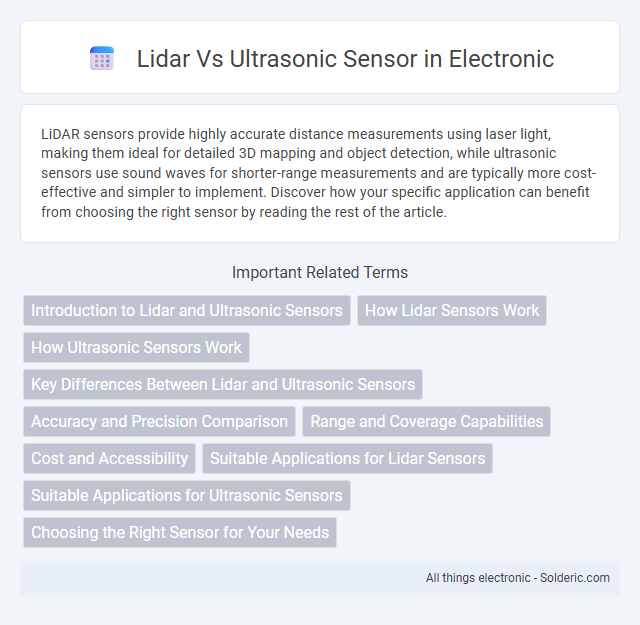LiDAR sensors provide highly accurate distance measurements using laser light, making them ideal for detailed 3D mapping and object detection, while ultrasonic sensors use sound waves for shorter-range measurements and are typically more cost-effective and simpler to implement. Discover how your specific application can benefit from choosing the right sensor by reading the rest of the article.
Comparison Table
| Feature | Lidar Sensor | Ultrasonic Sensor |
|---|---|---|
| Measurement Principle | Light detection and ranging using laser pulses | Sound waves reflection using ultrasonic pulses |
| Range | Up to 100 meters or more | Typically up to 5 meters |
| Accuracy | High accuracy (millimeter level) | Moderate accuracy (centimeter level) |
| Resolution | High spatial resolution | Lower resolution |
| Environmental Sensitivity | Works well in various lighting but affected by heavy rain/fog | Performance affected by temperature, humidity, and soft surfaces |
| Cost | Higher cost | Lower cost |
| Applications | Autonomous vehicles, mapping, robotics | Obstacle detection, level measurement, parking sensors |
| Size | Generally bulkier | Compact and lightweight |
Introduction to Lidar and Ultrasonic Sensors
Lidar sensors use laser pulses to measure distances by calculating the time it takes for the light to return after hitting an object, providing high-resolution 3D mapping and object detection. Ultrasonic sensors emit sound waves and measure the time delay of the echo to determine proximity, commonly used for short-range obstacle detection and level measurement. Lidar offers greater accuracy and range in complex environments, while ultrasonic sensors are cost-effective and suitable for basic distance sensing applications.
How Lidar Sensors Work
Lidar sensors use laser pulses to measure distances by emitting light waves and detecting their reflections from objects, creating highly accurate 3D maps of the environment. These sensors calculate the time it takes for each laser pulse to return, enabling precise distance measurement even in complex or low-light conditions. Your choice of lidar offers superior resolution and range compared to ultrasonic sensors, which rely on sound waves and provide less detailed spatial information.
How Ultrasonic Sensors Work
Ultrasonic sensors operate by emitting high-frequency sound waves that reflect off objects and return to the sensor, measuring the time taken for the echo to determine distance. These sensors excel in detecting objects regardless of color or transparency, making them reliable in various lighting conditions. You can utilize ultrasonic sensors for precise proximity detection in applications like robotics, automotive parking assistance, and industrial automation.
Key Differences Between Lidar and Ultrasonic Sensors
Lidar sensors use laser pulses to measure distances with high accuracy and long-range capabilities, typically exceeding 100 meters, while ultrasonic sensors rely on sound waves and generally operate within shorter ranges of up to a few meters. Lidar provides detailed 3D mapping and high-resolution spatial data, beneficial for autonomous vehicles and robotics, whereas ultrasonic sensors are cost-effective and effective for obstacle detection in simpler applications like parking assistance. The precision and range of lidar technology surpass the lower resolution and susceptibility to environmental factors such as temperature and noise in ultrasonic sensors.
Accuracy and Precision Comparison
Lidar sensors provide higher accuracy and precision than ultrasonic sensors by using laser pulses to measure distances with millimeter-level resolution, making them ideal for applications requiring detailed spatial information. Ultrasonic sensors rely on sound waves and typically offer lower resolution and accuracy, with a precision range of a few centimeters, which is sufficient for basic object detection but less effective for intricate mapping. Your choice between the two should consider the required accuracy level, with lidar excelling in environments where precise and detailed measurements are critical.
Range and Coverage Capabilities
LiDAR sensors offer superior range capabilities, typically detecting objects up to 100 meters or more with high precision, making them ideal for long-distance applications. Ultrasonic sensors have a shorter effective range, generally limited to around 4 to 5 meters, and provide a wider coverage angle but lower spatial resolution. The precise range and coverage of LiDAR enable detailed 3D mapping, while ultrasonic sensors are better suited for close-range obstacle detection in confined environments.
Cost and Accessibility
Lidar sensors generally come at a higher cost compared to ultrasonic sensors, making ultrasonic options more accessible for budget-conscious projects and widespread use in consumer electronics or simple obstacle detection. Despite the higher price, lidar provides superior accuracy and longer detection range, which may justify the investment for advanced applications requiring precise mapping or navigation. When choosing between the two, Your decision should weigh the affordability and availability of ultrasonic sensors against lidar's enhanced performance capabilities.
Suitable Applications for Lidar Sensors
Lidar sensors excel in applications requiring high-resolution 3D mapping and precise distance measurement, such as autonomous vehicles, aerial surveying, and robotics navigation. Their ability to capture detailed spatial information enables effective obstacle detection and environment modeling in complex scenarios. Industries like agriculture, construction, and smart city infrastructure benefit from lidar's accuracy and wide-range scanning capabilities.
Suitable Applications for Ultrasonic Sensors
Ultrasonic sensors excel in short-range distance measurement and object detection in applications such as parking assistance systems, level measurement in tanks, and proximity sensing for industrial automation. Their ability to operate effectively in harsh environments with dust, smoke, or varying lighting conditions makes them ideal for indoor and outdoor use in manufacturing and robotics. Ultrasonic sensors are cost-effective solutions for detecting clear or irregularly shaped objects where precise velocity measurement is not critical.
Choosing the Right Sensor for Your Needs
Lidar sensors offer high-resolution, long-range detection ideal for applications requiring precise distance measurement and detailed environmental mapping, such as autonomous vehicles and robotics. Ultrasonic sensors provide cost-effective, short-range object detection suitable for obstacle avoidance and level measurement in compact spaces. Selecting the right sensor depends on factors like range, accuracy, environmental conditions, and budget constraints to ensure optimal performance.
lidar vs ultrasonic sensor Infographic

 solderic.com
solderic.com